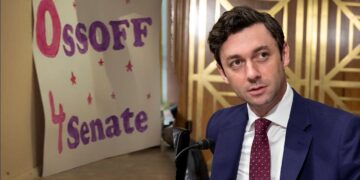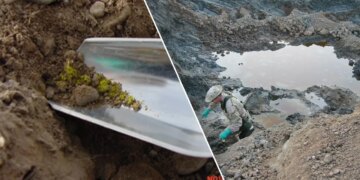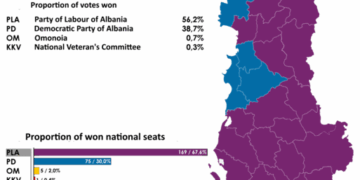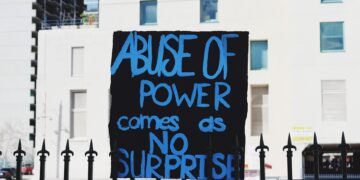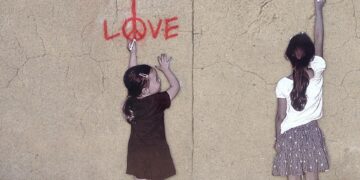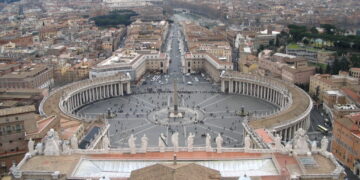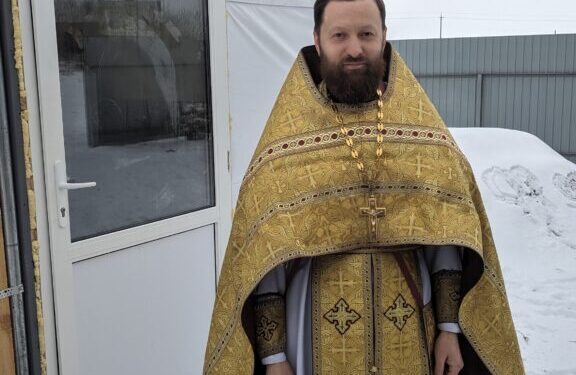As the Russia–Ukraine conflict continues well into its third year, we naturally focus on the military struggle. A less visible but equally important battle is being waged within Ukraine’s religious communities. This conflict reveals the complex interplay between faith, nationalism, state power, and the ongoing war.
Ukraine has historically been at the center of the Eastern European Orthodox world. It is on the banks of the Dnieper River in Kyiv that Eastern European Orthodoxy was born in 988 as a Slavic offshoot of Byzantium’s Greek Orthodoxy. It adopted Slavonic, a proto-Slavic tongue, as its liturgical language—a language the Ukrainian Orthodox Church (UOC), the largest religious organization in the country, still uses.
In 2019, the Orthodox Church of Ukraine (OCU) was founded in accordance with then President Petro Poroshenko’s “one nation, one church” vision. Poroshenko believed that an independent, national church was essential for national security, as opposed to the traditional UOC church, which was independent in governance but retained its legacy ecclesiastic connection with the Russian Orthodox Church based in Moscow. One way that the OCU displayed its nationalism was by replacing Slavonic with Ukrainian as its liturgical language.
Following Russia’s invasion of Ukraine on February 24, 2022, the Ukrainian government announced a series of measures identifying the UOC with the Russian Orthodox Church and seeking repressive measures against it. On December 2, 2022, during his nightly address President Volodymyr Zelensky announced a decree that banned the activities of religious organizations “affiliated with centers of influence” in Russia and said that state services would examine the links between the UOC and the Russian church.
If you were a Ukrainian patriot, President Zelensky signaled, the UOC could not possibly be your spiritual home.
Shortly after Zelensky’s speech, I attended liturgy at the Russian church in Geneva, where I was visiting, hoping to better understand the overlay of the war and religious identity. There, I met both Russians and Ukrainians, including Ukrainians from the Russian-speaking east and ethnic Ukrainians from the west. I met a veteran of the Ukrainian special forces, the SBU, who shared that he fought in the Donbas in 2014 and later went to Russia on a spiritual visit. He was highly critical of what he claimed was the persecution by the Ukrainian government of his church at home, the UOC. Clearly, there was more to it than President Zelensky’s narrative portraying the UOC as a political fifth column—a narrative echoed by the media in Europe and the United States.
The investigation that followed led me to both UOC and OCU parishes across Ukraine, from Chernivtsi to Khmelnytskyi, to Kyiv, and to Odessa, where I conducted in-depth interviews with parishioners, religious leaders, civil activists, government officials, parliamentarians, journalists, soldiers, and everyday Ukrainian faithful. These are my observations.
Church Seizures and Violence
In the dozens and dozens of parishes I visited across Ukraine last December, a similar pattern emerged: UOC priests and parishioners were violently expelled from their churches and left defenseless in a forced transfer of parishes to the OCU that has been unfolding since 2014.
In Korytne, near Chernivtsi, the local UOC parish had been forcibly removed from its church two weeks before. The parish had since been performing services in private homes. On the morning I visited, the parish was consecrating a new place for its church. The ceremony was led by the Chernivtsi metropolitan, Vladika Melety (Egorenko).
A crowd of faithful gathered outside, waiting for the arrival of Metropolitan Melety. The village was still, apart from a few dogs occasionally barking. The roads were unpaved, and the modest single-story building looked more like a barn than a church. Once liturgy began, the old and the young kneeled against the frigid pavement. Children were hugging a heater failing to rise to the occasion. Parishioners kept their winter jackets and gloves on. The room was too small for the parish’s 50 families. Two altar boys were coming and going to the back of the room to retrieve the necessary items for the mass from two large suitcases.
Two weeks ago, parishioners told me, individuals arrived at the church with fake documents to take possession of the property. These individuals did not belong to the UOC, they said. Some were from the village, some weren’t. They expelled parishioners and closed down the church.
The raid followed an illegal parish meeting that these individuals had called. Parishioners learned about that meeting on Facebook. The parish has its own statutes, and only the priest and parishioners can call such a meeting. The illegal meeting took place the day it was announced, indicating that the move had been planned in advance. The meeting produced new parish statute documents. Although they are illegal, local authorities recognize them.
Olena, a 60-year-old teacher, blames the division in the community on a handful of wealthy families in the village. These families do not attend the UOC church, but they initiated moves to take it over with the support of local authorities, she said. On one occasion, individuals broke into a church service wearing military gear. Complaints to authorities were made, to no avail. The mayor, who belongs to the OCU, is implicated in these actions, Olena said. He has led a concerted effort to make village church services in Ukrainian exclusively.
In Miliieve, the UOC church property was forcibly transferred to a predecessor church of the OCU in 2014. Parishioners were not present at the church when it was seized. Individuals claiming to be from the predecessor church illegally took ownership of the property and then re-registered it, with the support of the police, militia, and Ukrainian security services. This seizure was preceded by a formal parish meeting organized with the help of local and regional government officials. They prevented parishioners from attending the meeting.
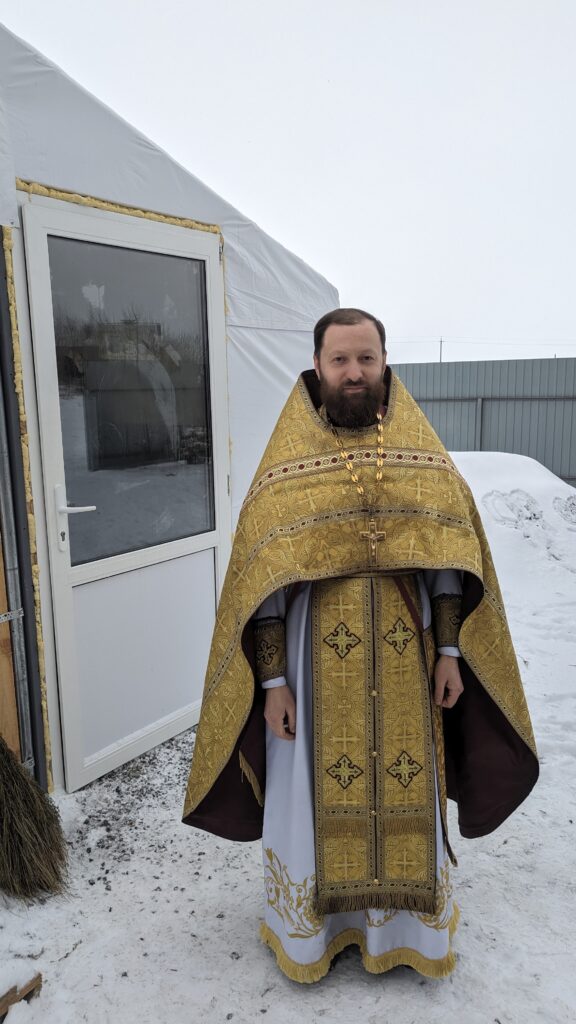
Ivan Verenka was the parish’s priest from 2007 to 2013. “Our church was taken away in 2014 on accusations of being Moscow-affiliated,” he told me. The UOC parish built a new church, which was criminally burned down this year, I was told.
In Zadubrivka, also near Chernivtsi, I joined the local parish for a Sunday service in a small private house. Parishioners had been holding services there since their church was expropriated. The space consisted of two small rooms, so small that the church’s choir huddled by the entry door, squeezing whenever someone entered or exited the building. The interior doors had been removed from their frames to make more space. Ramon, an assistant to the church secretary, told me that the lack of space is an issue on big holidays. About 300 families out of the village’s 800 to 900 families attended the UOC church.
Local authorities initiated the expropriation process in January 2019, I was told, claiming that a parish meeting held on January 24 had decided to switch the parish to the OCU. Around that time, groups of people periodically came to the church premises and threatened the parishioners gathered inside. Parishioners stayed overnight in the church to protect it. The threats escalated.
On May 30, 2019, as a dozen parishioners were praying outside the church, individuals wearing masks invaded the church premises and began beating people for about 20 minutes and breaking items inside the church. “The police were not as strong in 2019 and because of this we could stand and defend our church,” a parishioner told me, pointing to the lack of trust in law enforcement. A few parishioners were injured and went to the hospital.
In April 2023, parishioners were violently expelled from their church. It happened during the funeral of a soldier from the parish. Attackers in military uniforms and balaclavas broke into the church, broke doors, and beat parishioners, sending many to the hospital. Parishioners identified some attackers as being from the village. Others were not. Police and military people cordoned off the church to prevent parishioners from returning.
After the end of Sunday liturgy, I visited the seized church, now under OCU control, a few yards away. A handful of faithful were inside, compared with the tightly packed private house where the dispossessed had gathered. A large Ukrainian flag was flying on the top of the church. When was the flag placed, I asked. After the takeover, I was told.
In Malyi Kuchuriv, in Chernivtsi, the parish now gathers under white tarps where I joined them for a Sunday service. Half of the parishioners reportedly don’t attend because of the cold and unsuitable conditions. Their previous church, built entirely by their own hands, was seized on March 18, 2023, and transferred to the OCU.
George, a 40-year-old choir singer, recounted the day the church was seized with the help of the police. It took place during liturgy, he said. “I was inside during the liturgy when I heard someone cry out in pain. A group of individuals had arrived with forged parish documents stating that the parish had switched to the OCU.” He added that they did not belong to church or the village and came with fake documents from the oblast. Parishioners inside the church called the police, but the police helped the assailants.
He showed me photos and videos of the seizure. Parishioners were beaten, including with iron pipes. George was hurt. An assailant, whom he claimed was the secretary of the oblast mayor, cut one of his fingers with an iron bar. In one photo, a man could be seen standing in the church premises wrapped in an Ukrainian flag. Another photo showed the detached part of a finger in a pool of blood.
Father Petro, who was the parish’s head priest for 14 years, also showed me videos of the event. He said the group who seized the church did not belong to the parish and came with local authorities and police, saying, “Force is on our side.” A bloody fight ensued, with children and elderly people beaten while police stood by and watched, he said. The entire parish was then forced outside, the church doors were locked, and religious and personal items were taken away, including the priest’s personal belongings.
According to Father Petro, during a subsequent meeting with local authorities, the mayor refused their request for a house of prayer, saying, “We don’t have a place for such enemies as you are.” Another parishioner said members of the SBU were present at the seizure, as well as “military people.”
In Tovtry, about 30 kilometers from Chernivtsi, the village’s UOC parish met in a converted shop. Their church was seized in May 2019, when police arrived with officials demanding the keys to the church. When the priest refused, they returned in his absence and broke the locks. No parishioners were present when they entered. An attorney representing the parish filed a complaint stating that the seizure was illegal, but law enforcement reportedly dismissed the complaint, showing the parish’s attorney documents establishing that the parish had decided to switch to the OCU.
After the church was expropriated, the parish initially prayed outside the church before being prohibited from coming onto the church property. They then gathered on the road. When the weather became too cold, they moved to a shop converted into a place of worship, thanks to a local business owner and donations from parishioners. Metropolitan Melety later came to consecrate the shop-turned-temple.
When I visited the old church property, it appeared silent and empty, with lights off and gates closed.
In Hvardiiske, in Khmelnytskyi, rumors of expropriation began to circulate in 2018. In 2019, a group of residents who were not parishioners decided to form a new parish affiliated with the OCU. I was told by the UOC parish’s priest and parishioners that a wealthy local farmer named Viktor Anadolich of the Greek Catholic confession initiated this move and gathered 800 signatures, including people from neighboring villages. On February 3, 2019, these individuals called a formal parish meeting where it was decided that the UOC parish was now the OCU’s. The parish was subsequently reregistered under this new statute, and the church building was locked. Parishioners were forced to pray outside for three years. Their church is still locked and empty, they said.
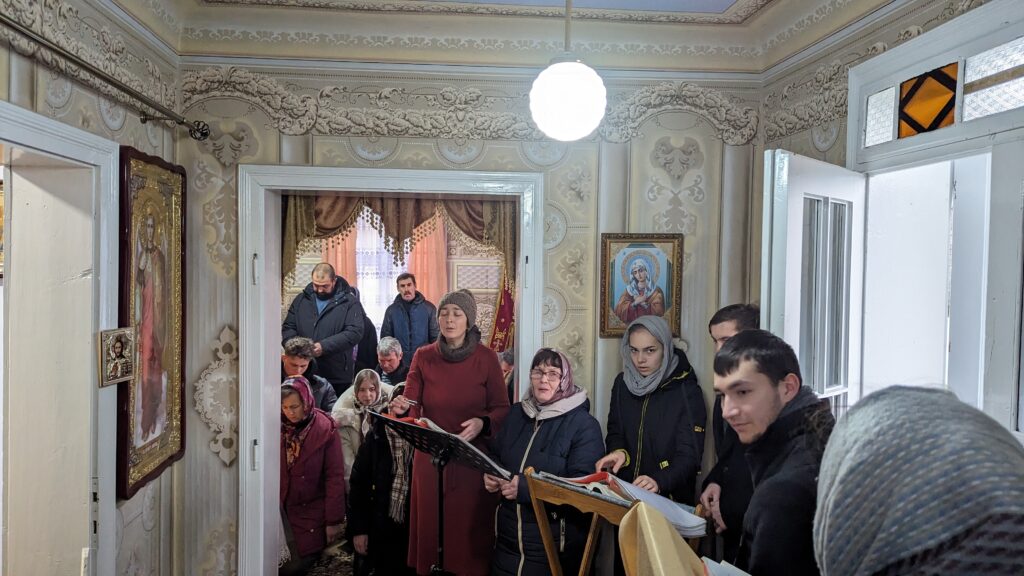
In Raikivtsi, in Khmelnytskyi, the parish has been meeting in a private home since local authorities, including the mayor, seized the church building in 2019. The mayor, Hanna Shevchuk, claimed that the seizure was legal, I was told. Parishioners were allowed to take only a fraction of their religious and personal items from the church. “Some icons, not even the church’s prayer books,” parishioners told me. A woman parishioner gave her house until the war began. She then became afraid of persecution, and the parish moved to a newly built church. The unheated building was cold and damp when I visited. Parishioners said that the OCU currently does not use their seized church.
In Ruzhychna, in Khmelnytskyi, parishioners of the Ascension of the Mother of God now meet in a white tent built with tarps. The temperature inside was just as cold as the outside when I visited. The seizure of their old church was validated by courts and local authorities, Archpriest Volodymyr, who leads the parish, told me. The special list of people who claimed to have switched their parish to the OCU was sent to the regional administration, along with the fake parish statute documents. They took the registration and seized our church, he told me—the same as elsewhere, he added. On June 5, 2022, military personnel arrived and replaced the locks on the gates of the church.
In Trebukhiv, a suburb of Kyiv, I attended a church service led by Father Mihail in a tent made of tarps. Inside, icons and candles recreated the rudiments of a normal church. Snow piled up against the walls outside. The tent had only a small wood-fired heater that provided little warmth but plenty of fire hazard . The parish’s old church was seized on April 22, 2023, when a crowd broke into the building and presented what Father Mihail said were illegal documents claiming that the parish had been officially transferred to the OCU. That same day, Father Mihail and his family were driven from their house. “My 7-year-old daughter, wife, and I were expelled from our house when our church was seized,” Father Mihail said. Now, “my daughter is bed-wetting.” That evening, the news media reported matter-of-factly that his parish had switched to the OCU.
In Kyiv, after visiting parishes in and around the city, while driving back, my guide, Father Sergiy, mentioned to me that he was at risk of arrest. I asked why. For helping my church defend itself, he said. Father Sergiy had fled Russian-occupied Kherson in 2022, because he refused to work under Russian occupation. In Kyiv, the young priest helped coordinate the defense of his new church when it was targeted by expropriation and violence.
The Ukrainian government arrested and imprisoned Father Sergiy a few weeks after my visit. In April, a mutual friend messaged me: “We are worried about his health. He does not have his medication, he is very sick. We don’t know how long he will be in jail.”
A Failing Judiciary
The judicial system, when it got involved, failed the parishes I visited. When a parish sought legal recourse for church seizures, acts of violence, or other abuses, court cases were dismissed, delayed, ignored, or closed, or the illegal re-registration of the parish was validated.
In Hvardiiske, a court ruling validated the parish re-registration to the OCU. The case dragged on for three years after the church was seized on February 3, 2019, during which time the parish prayed and held liturgy outside. After multiple appeals, the courts eventually ruled against the UOC parish and closed the case.
In Boyarka, near Kyiv, the parish decided to give up on a costly, protracted court case. The parish’s church was seized in April 2023, and the community began holding services in homes, in the forest, and under a makeshift tent. Their case rested on the claim that the meeting deciding on the transfer of the parish to the OCU was illegal. After multiple time-consuming and costly hearings and procedures, the parish dropped the case. The court did not refund the legal fees, they said.
In Trebukhiv, the court case was repeatedly postponed. After Father Mihail’s church was seized in April 2022, based on illegal re-registration documents, Father Mihail initiated a legal procedure to challenge the seizure and presented the parish’s statute documents to the court. The case has been postponed repeatedly and is still waiting.
Weaponizing Military Conscription
Military conscription has been used as a weapon against the UOC. In Khmelnytskyi’s Ruzhychna district, where parishioners of the Intercessional Blessed Virgin Mary were expelled from their place of worship in April 2023, military officers came by multiple times to conscript parishioners during services in the private home where they had relocated. Many men from the parish do not attend services anymore, parishioners said. They believe the conscription is selective because of their affiliation with the UOC.
In Krasyliv, parishioners of the UOC were expelled from their place of worship and relocated to a small private home. After villagers identified the new location, parishioners reported being harassed by representatives of the military who attempted to conscript men during Sunday services. Military officers came multiple times during liturgy to hand out draft notifications. Parishioners say they did not see officers visit any other homes in the neighborhood.
In Korytne, a parishioner whose son is currently fighting in the war, and who introduced himself as a patriot, said that some members of the parish were afraid to go to the church because their sons and husbands would be taken to the war.
A Hostile Media
A common theme has been the role of media and social media in antagonizing the UOC. In Khmelnytskyi, at the cathedral of St. George the Victorious on April 2, 2023, two individuals pushed a deacon who was reading the gospel and recorded the incident and the melee that followed. Videos of the event, which only showed the melee, were broadcast that same day by local TV channel Expresso.
Shortly after, parish members recounted that “an ocean wave” of people angered by the news segment gathered at the cathedral, threatening “pro-Russians.” The crowd split into two parts. Young, aggressive people began attacking the building to enter it. Another group organized an impromptu election in the cathedral yard to switch the parish to the OCU. Six tables with lists ready with signatures were set up. After 7 PM, the crowd moved in to expel parishioners and priests. I saw a video of a young priest being chased and harassed on his way home.
“They call us Moscovite,” said Ivan Verenka, the assistant priest of the UOC parish in Miliieve, referring to his fellow villagers. “But they know us, they know we are Ukrainains.” So why do they call you that, I asked. Television and other media sources have influenced the community’s beliefs, Verenka claims. “They believe the media, not the people, not the priests,” he said. Former friends now insult Verenka and have threatened violence. “How can we still be friends?”
Father Nikita, a lawyer who represents the church in multiple legal cases, told me that the UOC is being informationally blocked, with details about church seizures, attacks, and other incidents being suppressed on media and social media. The government, he said, is using the SBU to persecute the UOC by fabricating criminal cases to portray the church as criminal and then disseminating this information on social media.
State and Church
I asked the Ukrainian government’s religious affairs czar, Viktor Yelensky, about the concerns over church properties being forcibly transferred from the UOC to the OCU. This is a matter for the local government, Yelensky explained to me in his office in Kyiv. The central government was not involved.
I asked about the impact on UOC parishes of the measures his government initiated, such as those Zelensky announced in his February 2022 speech. UOC parishioners and clergy had told me that authorities were targeting their church in the name of national security.
Yelensky claimed that his government did not treat any religious actor in a discriminatory manner. He also said that his office offered the UOC, in the form of a public letter, an opportunity to voluntarily demonstrate the actions the church had taken to sever ties with the Russian Orthodox Church. “For reasons I cannot fully understand, they did not hear my suggestions,” he said.
UOC clergy I spoke to said that they did respond to Yelensky’s many such letters. They questioned what Yelensky meant by “breaking all ties with the ROC.” If he was referring to being controlled by Moscow or supporting the aggressor, then the UOC had already ended any such ties. In fact, they said, the last remaining link to the ROC was mentioning ROC Patriarch Kirill in the liturgy, as is done with all other living Orthodox patriarchs. This mention has been removed. The UOC is for all intents and purposes a self-governing church, as detailed at the Council of the Ukrainian Orthodox Church on May 27, 2022. For example, the church appoints and is solely responsible for its bishops and priests.
The UOC clergy also argued that Yelensky’s requests were both cynical and unconstitutional. The clergy warned that, if the UOC were to make a public political statement declaring the UOC’s complete break from the ROC, the ROC would likely initiate a schism procedure, leading other national Orthodox churches to view the UOC differently and causing the UOC to lose its canonical dignity. The UOC clergy speculated that damaging the UOC’s canonical standing within the global Orthodox community might well be the Ukrainian government’s real intention.
United Nations Concerns
Although it has received little attention in the United States, the United Nations has taken notice of the acts of violence, church seizures, and abuses against UOC communities in Ukraine and is actively looking into the matter.
My visits often took place in the footsteps of UN experts, who were conducting their own investigations. Reading through some of the reports their investigations produced, I recognized many findings similar to my own.
Take, for example, the quarterly report published by the UN’s highest human rights authority, the High Commissioner for Human Rights. The July 2024 edition found that “Ukrainian authorities continued to take actions against individuals associated with the Ukrainian Orthodox Church (UOC).”
The previous quarter’s report documented a case that took place just a few days after I left Ukraine, the seizure of the Kazan cathedral in Vinnytsia:
On 28 December 2023, a group of persons attacked the Kazan temple in Ladyzhyn, Vinnytsia region, with at least two individuals involved in this attack claiming to be active servicemen of Ukrainian armed forces. Police officers present at the site did not intervene.
Subsequently, on 9 January 2024, a group of about 30 individuals wearing camouflage uniforms without insignia used two heavy construction vehicles to break the gates and fence of the temple and forced their way into the UOC church. They beat the clergyman and two male parishioners, all of whom suffered minor injuries. At least nine individuals were physically attacked during the two incidents. Only two victims submitted complaints to police, one of which was later withdrawn. Most victims said they did not submit complaints because they feared retaliation, such as threats from their neighbors or dismissal from their jobs.
The UN human rights reports also describe the role played by the legal system and local authorities: “OHCHR recorded six cases across five regions where groups of people forcefully broke into UOC churches, justifying their actions with decisions from local authorities to register new religious communities of the Orthodox Church of Ukraine (OCU) at the same address as existing UOC communities.”
The reports align with my observations on the failure of law enforcement to protect victimized UOC communities: “OHCHR has previously documented that law enforcement agencies did not take appropriate measures to prevent and react to violence related to conflicts involving the UOC.”
The UN’s worries about religious freedom in Ukraine did not start with the current war. As far back as October 2018, several UN special rapporteurs sent a joint letter to the government of Ukraine alerting it to a series of acts of violence that appeared to contravene the internationally recognized right to freedom of religion and belief. The incidents included attacks against and seizure of places of worship belonging to the UOC and acts of intimidation and harassment, including death threats made against priests.
During our interview in Ruzhychna, Archpriest Volodymyr mentioned that two years ago he had received a visit from UN experts, whom he told about his parish’s fate. Two years later, he was still leading the Ascension of the Mother of God parish under tarps.
Fighting and Dying for Ukraine
The dozens and dozens of UOC parishioners I interviewed during my visit considered themselves patriotic, just as the OCU parishioners I talked to did. Many had personal stories of volunteering, fighting, and dying for their country.
“We are patriots, we have helped our army from the beginning [of the war],” Archpriest Volodymyr told me. “We even received certificates attesting to the help we provided to the army.” He showed me a flag the members of the 33rd Special Mechanized Brigade of the Armed Forces of Ukraine signed in gratitude for the support his parish provided. I asked what kind of support. Technical assistance, food, bread, clothes, and all things needed, he said. They provide what they are asked to donate, what the soldiers on the frontline need at the moment. I asked whether his parishioners continued to do this despite the expropriation of their church. Yes, he said, noting that the 33rd Special Mechanized Brigade sent the signed flag a month ago. One member of his parish serves as a volunteer with the brigade, he added.
Father Yuri of the Saint Trinity Cathedral showed me a similar signed flag presented by the soldiers of the Chernihiv brigade of the armed forces of Ukraine in recognition of the help his church provided. The brigade is composed of members from his parish. I asked father Yuri if many members of his parish served on the front line. He pulled out a book with page after page filled with names listed for prayers. He said that over 100 soldiers had served, three had died, and many had been injured.
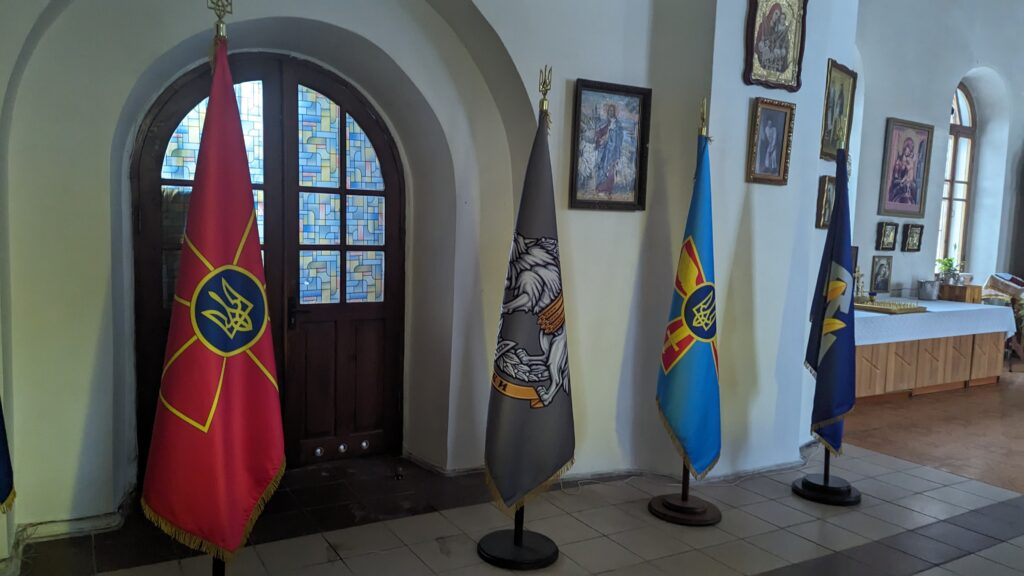
Subscribe Today
Get daily emails in your inbox
A soldier from Archpriest Volodymyr’s parish died and his body was returned to the village the day before my visit. The funeral was the following day. He was the third parishioner to make the ultimate sacrifice since the war began in February 2022.
In Hvardiiske, Tania, a 45-year-old mother, told me that she lost her 26-year-old son in the war. The OCU clergy of her expropriated church tried to prevent her son from being buried in the church’s cemetery. Parishioners mentioned another case where a soldier’s burial was prevented. When asked about the number of soldiers from the parish involved in the war, I was shown a list indicating that approximately 60 soldiers from this community alone are fighting. One parishioner, Luboi, said that her grandson is currently at the front.
In Zadubrivka, the church was expropriated during the funeral of a soldier. I inquired about how many soldiers from the village had died. Five soldiers had lost their lives, I was told.
In Korytne, I interviewed Michael, a 59-year-old UOC parishioner. He said he had served for one year and three months in the current war and fought in Bakhmut and Kharkiv. “Among the soldiers, we help each other without concern for which church we belong to,” he said. He expressed dismay at being called pro-Russian while having fought for Ukraine. “If we are patriots and fight for our country, why is our church accused of being influenced by Russia?”





